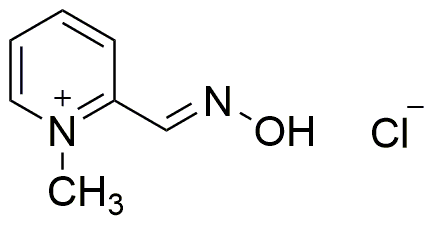1-Methylpyridinium-2-aldoxime chloride is widely utilized in research focused on:
- Antidote Development: This compound is primarily known for its role as an antidote for organophosphate poisoning, providing a critical solution in emergency medicine and toxicology.
- Pesticide Detoxification: It is effective in detoxifying pesticides, making it valuable in agricultural practices to mitigate the harmful effects of chemical exposure on crops and farm workers.
- Analytical Chemistry: Researchers use this compound in analytical methods to detect and quantify organophosphates in environmental samples, ensuring safety and compliance with regulations.
- Pharmaceutical Research: The compound is explored in drug formulation studies, particularly in developing therapies for neurological conditions resulting from chemical exposure.
- Biochemical Studies: It serves as a tool in biochemical research to understand enzyme inhibition and reactivation processes, aiding in the development of safer chemical alternatives.
General Information
Properties
Safety and Regulations
Applications
1-Methylpyridinium-2-aldoxime chloride is widely utilized in research focused on:
- Antidote Development: This compound is primarily known for its role as an antidote for organophosphate poisoning, providing a critical solution in emergency medicine and toxicology.
- Pesticide Detoxification: It is effective in detoxifying pesticides, making it valuable in agricultural practices to mitigate the harmful effects of chemical exposure on crops and farm workers.
- Analytical Chemistry: Researchers use this compound in analytical methods to detect and quantify organophosphates in environmental samples, ensuring safety and compliance with regulations.
- Pharmaceutical Research: The compound is explored in drug formulation studies, particularly in developing therapies for neurological conditions resulting from chemical exposure.
- Biochemical Studies: It serves as a tool in biochemical research to understand enzyme inhibition and reactivation processes, aiding in the development of safer chemical alternatives.
Documents
Safety Data Sheets (SDS)
The SDS provides comprehensive safety information on handling, storage, and disposal of the product.
Product Specification (PS)
The PS provides a comprehensive breakdown of the product’s properties, including chemical composition, physical state, purity, and storage requirements. It also details acceptable quality ranges and the product's intended applications.
Certificates of Analysis (COA)
Search for Certificates of Analysis (COA) by entering the products Lot Number. Lot and Batch Numbers can be found on a product’s label following the words ‘Lot’ or ‘Batch’.
*Catalog Number
*Lot Number
Certificates Of Origin (COO)
This COO confirms the country where the product was manufactured, and also details the materials and components used in it and whether it is derived from natural, synthetic, or other specific sources. This certificate may be required for customs, trade, and regulatory compliance.
*Catalog Number
*Lot Number
Safety Data Sheets (SDS)
The SDS provides comprehensive safety information on handling, storage, and disposal of the product.
DownloadProduct Specification (PS)
The PS provides a comprehensive breakdown of the product’s properties, including chemical composition, physical state, purity, and storage requirements. It also details acceptable quality ranges and the product's intended applications.
DownloadCertificates of Analysis (COA)
Search for Certificates of Analysis (COA) by entering the products Lot Number. Lot and Batch Numbers can be found on a product’s label following the words ‘Lot’ or ‘Batch’.
*Catalog Number
*Lot Number
Certificates Of Origin (COO)
This COO confirms the country where the product was manufactured, and also details the materials and components used in it and whether it is derived from natural, synthetic, or other specific sources. This certificate may be required for customs, trade, and regulatory compliance.


